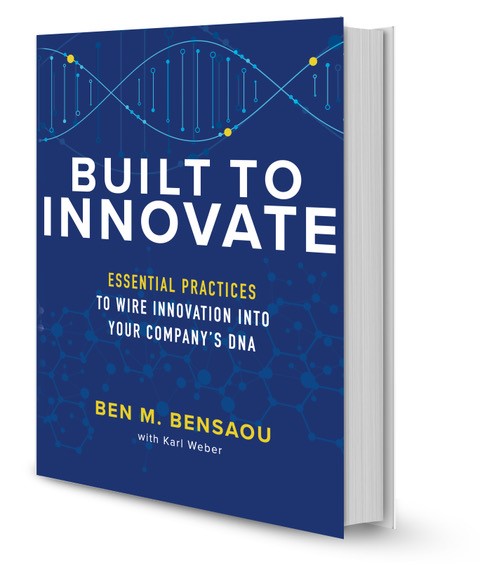Excerpted for Eczacıbaşı Life Magazine from "Built to Innovate: Essential Practices to Wire Innovation into Your Company's DNA" written by INSEAD Professor of Technology Management and Comparative Management Ben M. Bensaou (McGraw Hill, pp. 23-27, September 2021).
The year is 1958, one year after the Union of Soviet Socialist Republics, nicknamed "the Reds" by the American media, launched the Sputnik satellite into space. The Americans are in a deep panic, fearing nuclear missiles raining down on them from space. Across the country, tremendous R&D activity has begun.
It was in this environment that the materials company W. L. Gore was founded in Newark, Delaware, USA by Wilbert Gore, an outstanding chemical engineer, and his wife Genevieve. Bill Gore was fascinated by the innovative potential of a then little-known substance known as polytetrafluoroethylene (PTFE). A few years later, PTFE would become famous as a coating for cookware under the brand name of Teflon. But in the meantime, Bill Gore and his son Bob had discovered that PTFE could be “stretched” in the lab to form a microporous structure that is 70 percent air.
A brand-new product: GORE-TEX
The Gores commercialized PTFE as Gore-Tex, a waterproof yet breathable fabric membrane ideal for creating all-weather garments. To this day, it’s considered the gold standard for outdoor wear. And dozens of other uses have been found for Gore-Tex, from making meshes, sutures, and other medical appliances to serving as a laminate to help preserve fragile illuminated manuscripts from the Middle Ages.
In the decades since then, the Gore company has grown by discovering creative new uses for materials—not just Gore-Tex, but a continually expanding range of other materials created using modern chemical methods. This track record of successful innovation has its roots in principles and practices that go back to founders Bill and Genevieve Gore and that continue to shape the organization today.
“Spend 10 percent of your time “dabbling” in projects that appeal to you”
One of the practices pioneered under Bill Gore’s leadership was that of encouraging all of the company’s associates (as they are always called) to spend 10 percent of their time “dabbling” in projects that appealed to them. Over time, Gore’s Dabble Time system produced some of the biggest business successes enjoyed by the enterprise (again, the term that Gore prefers).
For example, back in the early 1990s, engineer Dave Myers, an associate in Gore’s medical division and an avid biker, noticed that a PTFE coating made the cables on his mountain bike especially resistant to oil and grit. Curiosity piqued, he wondered whether the same concept might protect and enhance the sound of guitar strings. That led to three years of tests and experimentation by Myers and a few like-minded colleagues whose support and help he solicited. Ultimately, the team developed guitar strings that hold their tone three times longer than the then-current standard. Today, Gore’s ELIXIR brand guitar strings are the industry’s bestsellers.
What are exactly “execution and innovation engines?”
The story of how Myers’s Dabble Time investigations led to a whole new business opportunity for W. L. Gore illustrates the first requirement for enhancing your organization’s innovation capabilities. Every organization needs to operate two different engines simultaneously: an execution engine and an innovating engine.
The execution engine is about doing your current work as skillfully, efficiently, and flawlessly as possible. The execution engine drives how products get made, services get delivered, records get maintained, sales get transacted, and other daily activities get completed.
The innovating engine, on the other hand, may seem to get nothing done. It’s about looking for new ideas—imagining new products or services, designing new work methods or processes, experimenting with new technologies, learning about new markets, or investigating customer (and noncustomer) needs and desires that you’ve never previously tried to address.
Many organizations understand the need for both an execution engine and an innovating engine. But many make the mistake of thinking that the two engines ought to be separately staffed, organized, and managed. Some assume that a traditional team of scientists or engineers staffing a research and development (R&D) department can be expected to churn out all the innovations that the organization needs. The fact is that all of your company’s employees should find themselves working in both engines, dedicating some of their time and energy to execution and some of both to innovating. But they’ll need to adopt dramatically differing mindsets depending on which engine they are part of at a given moment.
Note that this is an alternative approach to building what is often called an “ambidextrous organization,” capable of looking to the future while simultaneously perfecting the way it operates in the present day. The traditional concept of the ambidextrous organization assumes that different teams focus on these two contrasting tasks. However, I recommend that “ambidexterity” should be embedded in every organizational department and level, beginning with each individual employee.
The mindset of the execution engine is skeptical, logical, demanding, and rigorous. In organizing and managing the execution engine, efficiency is the paramount goal. Thus, in defining what tasks will be performed by the execution engine and exactly how those tasks will be handled, all the many financial metrics used to define business success—return on investment (ROI), return on equity (ROE), earnings before interest and taxes (EBIT), the Berry ratio, and more—may be brought into play.
Everything the execution engine does must be justified as a contribution to value, either for the customers or for the organization; anything that fails to pass this test must be ruthlessly improved, streamlined, or eliminated.
Managing the innovating engine is quite a different matter. The mindset of the innovating engine is open-minded, imaginative, accepting, and flexible. Ideas and possibilities that are floated by the innovating engine are—at least temporarily— embraced without concern about whether they are practical, how to make them happen, how they will be used to generate revenues, and what sort of profit margins they might yield. If the ideas excite a strong enough response from members of the organization, there will be plenty of time later to evaluate and test them according to logical principles and cost-benefit analyses before they are implemented by the execution engine.
Which is preferable for long-term success?
Both the execution engine and the innovating engine are essential to the long-term success of the organization. But in many organizations, the innovating engine doesn’t get the attention it deserves. That’s understandable. After all, the execution engine is what keeps the organization running on a day-to-day basis. If it shuts down or stops working efficiently, the customers disappear, the revenues and profits dry up, and the business quickly dies.
By contrast, the value created by the innovating engine isn’t as obvious, and it takes longer to come to fruition. In the short run, an organization can get by without innovating, just by doing the same things it has always done. It takes time for the failure to innovate to take its toll on the organization; it happens only as changing markets, evolving customer needs, and emerging competitive threats gradually make the old ways of doing things obsolete. When the damage becomes too significant to ignore, company leaders finally realize—too late—that they should have been paying attention to the innovating engine all along.
The smartest business leaders don’t let that happen. Thus, any company that wants to improve its capabilities for innovating can start by looking at how well its innovating engine is engaging the creative efforts of people throughout the organization, in every division and department and at all three operational levels: among frontline employees, midlevel managers, and senior leaders.


